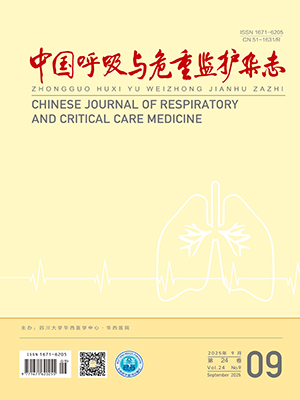| 1. |
刘新春, 钟玉婷, 何清, 等. 塔克拉玛干沙漠腹地沙尘暴过程大气颗粒物浓度及影响因素分析. 中国沙漠, 2011, 31(6): 1548-1553.
|
| 2. |
Atkinson RW, Kang S, Anderson HR, et al. Epidemiological time series studies of PM2.5 and daily mortality and hospital admissions: a systematic review and meta-analysis. Thorax, 2014, 69(7): 660-665.
|
| 3. |
Cao XJ, Lei FF, Liu H, et al. Effects of dust storm fine particle-inhalation on the respiratory, cardiovascular, endocrine, hematological, and digestive systems of rats. Chin Med J (Engl), 2018, 131(20): 2482-2485.
|
| 4. |
雷丰丰, 党雅梅, 张长青. 沙尘暴对大鼠肺组织影响的病理学观察. 中华病理学杂志, 2015, 44(3): 199-201.
|
| 5. |
雷丰丰, 王学斌, 刘华. 沙尘气溶胶暴露对大鼠肺功能及肺组织病理学影响的研究. 中华医学杂志, 2015, 95(32): 2634-2638.
|
| 6. |
贾晓鹏, 王海兵. 甘肃河西地区大气沙尘成分及影响分析. 中国沙漠, 2009, 29(1): 156-161.
|
| 7. |
邵龙义, 李卫军, 杨书申, 等. 2002 年春季北京特大沙尘暴颗粒的矿物组成分析. 中国科学 D 辑: 地球科学, 2007, 37(2): 215-221.
|
| 8. |
Lei FF, Luo WY, Dong ZB, et al. An investigation of the effects of dust storms on rat lung using HRCT and blood gas analysis. Sci Cold Arid Regions, 2016, 8(4): 319-324.
|
| 9. |
Policard A, Collet A. Deposition of silicosis dust in the lungs of inhabitant of the Saharan regions. AMA Arch Ind Hyg Occup Med, 1952, 5(6): 527-534.
|
| 10. |
李盛, 王金玉, 李普, 等. 沙尘天气的呼吸系统健康效应及机制研究进展. 环境与健康杂志, 2019, 36(1): 78-82.
|
| 11. |
Craig VJ, Zhang L, Hagood JS, et al. Matrix metalloproteinases as therapeutic targets for idiopathic pulmonary fibrosis. Am J Respir Cell Mol Biol, 2015, 53(5): 585-600.
|
| 12. |
Kang H. Role of microRNAs in TGF-β singling pathway-mediated pulmonary fibrosis. Int J Mol Sci, 2017, 18(12): E2527.
|
| 13. |
Kasabova M, Joulin-Giet A, Lecaille F, et al. Regulation of TGF-β1-driven differentiation of human lung fibroblasts: emerging roles of cathepsin B and cystatin C. J Biol Chem, 2014, 289(23): 16239-16251.
|
| 14. |
Ohno Y, Nakanishi T, Umigai N, et al. Oral administration of crocetin prevents inner retinal damage induced by N-methyl-D-aspartate in mice. Eur J Pharmacol, 2012, 690(1-3): 84-89.
|
| 15. |
张伟, 郑建, 朱雪, 等. 益气类中药对肺纤维化大鼠模型肺组织中 TNF-α、IL-8 的影响. 中华中医药学刊, 2014, 32(10): 2311-2313.
|
| 16. |
Yao HW, Xie QM, Chen JQ, et al. TGF-beta1 induces alveolar epithelial to mesenchymal transition in vitro. Life Sci, 2004, 76(1): 29-37.
|
| 17. |
章巍, 刘新民, 李海潮, 等. 博来霉素致大鼠肺纤维化模型肺组织 MMP-2、MMP-9、MT1-MMP 及 TIMP-1、TIMP-2 的表达. 北京大学学报(医学版), 2002, 34(6): 716-721.
|
| 18. |
Wang A, Wang F, Yin Y, et al. Dexamethasone reduces serum level of IL-17 in bleomycin-A5-induced rats model of pulmonary fibrosis. Artif Cells Nanomed Biotechnol, 2018, 46(4): 783-787.
|
| 19. |
Yang D, Yuan W, Lv C, et al. Dihydroartemisinin suppresses inflammation and fibrosis in bleomycin-induced pulmonary fibrosis in rats. Int J Clin Exp Pathol, 2015, 8(2): 1270-1281.
|
| 20. |
安方玉, 颜春鲁, 刘永琦, 等. 泻肺汤对肺纤维化大鼠 TGF-β1/Smads 信号转导通路的干预研究. 中华中医药杂志(原中国医药学报), 2018, 33(6): 2641-2645.
|
| 21. |
胡洋, 李惠萍. PM2.5 对肺纤维化的影响. 临床内科杂志, 2015, 32(4): 228-230.
|
| 22. |
Fujita H, Sakamoto N, Ishimatsu Y, et al. Effects of doxycycline on production of growth factors and matrix metalloproteinases in pulmonary fibrosis. Respiration, 2011, 81(5): 420-430.
|
| 23. |
陈雅萍, 宋志芳. 尘源性炎症反应与矽肺纤维化的关系. 中国工业医学杂志, 1999, 12(2): 75-77.
|
| 24. |
Zheng X, Qi C, Zhang S, et al. TGF-β1 induces Fstl1 via the Smad3-c-Jun pathway in lung fibroblasts. Am J Physiol Lung Cell Mol Physiol, 2017, 313(2): L240-L251.
|




